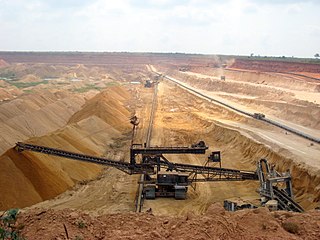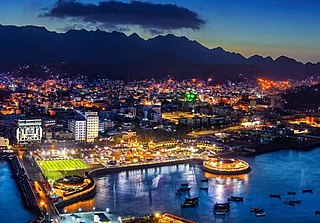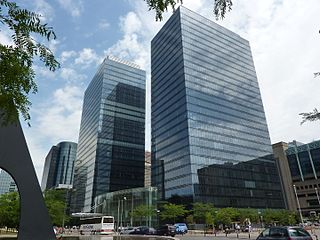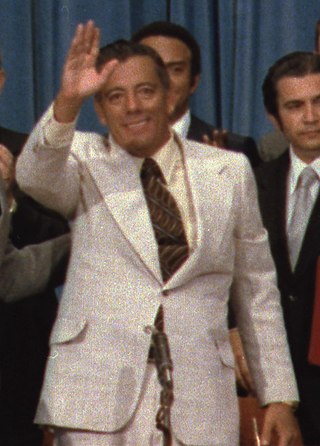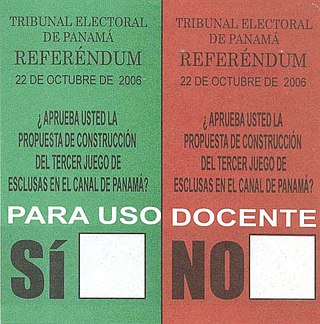1970s-present
This section needs to be updated.(October 2022) |
In the 1970s and 1980s, Panama's growth fluctuated with the vagaries of the world economy. After 1973, economic expansion slowed considerably as a result of a number of international and domestic factors. Real GDP growth averaged 3.5% a year between 1973 and 1979. In the early 1980s, the economy rebounded with GDP growth rates of 15.4% in 1980, 4.2% in 1981, and 5.6% in 1982. The acute recession in Latin America after 1982, however, wreaked havoc on Panama's economy. GDP growth in 1983 was a mere 0.4%, but -0.4% in 1984. [4]
This period coincided with the rise to power of General Manuel Noriega, during which Panama became increasingly indebted. By 1986 the country owed SDR284m (US$360m) to the IMF alone, 278% of its quota. [7] This led to the IMF imposing an adjustment program supported by an IMF stand-by arrangement in 1985–87 [7] whilst the economy recovered somewhat. In 1985 Panama experienced economic recovery with 4.1% GDP growth. The corresponding figure for 1986 was estimated to be 2.8%. [4]
The United States started to pursue Noriega for fostering a narco-state in Panama, culminating in sanctions that froze Panama's assets in the United States, and because Panama used the US dollar it was forced to default on its IMF debt on 28 December 1987. [7] Economic turmoil in the country included a general strike and the banking system closing down for two months. [7] Panama made a token payment the day before the IMF meeting in November 1988, but the situation did not resolve until 1989. [7] Presidential elections in May 1989 were condemned by the international community as fraudulent and the IMF began to become impatient with Panama's increasing arrears which had now reached SDR121m (US$150m). [7]
The United States and Germany forced through a resolution on 30 June 1989 declaring Panama ineligible for further support from the IMF. [7] The United States invaded Panama in December 1989 and forced the surrender of Noriega. [7] SDR181.5m (~$US230m) was still owed to the IMF in April 1990, but the country regained access to IMF funds on 2 May 1992. [8]
After taking office in 1994, President Ernesto Perez Balladares instituted an economic liberalization program designed to liberalize the trade regime, attract foreign investment, privatize state-owned enterprises, institute fiscal discipline and privatize its two ports in 1997 and approve the sale of the railroad in early assets.[ clarification needed ] Panama joined the World Trade Organization (WTO) and a banking reform law was approved by the legislature in early 1998 and dismantled the central bank. After two years of near stagnation the reforms began to take root, with GDP growing by 3.6% in 1997 and more than 6% in 1998. The most important sectors which drove growth were the Panama Canal and the shipping and port activities of the Colón Free Trade Zone which also rebounded from a slow year in 1996.
On 1 September 1999, Mireya Moscoso, the widow of former President Arnulfo Arias Madrid, took office. During her administration, Moscoso attempted to strengthen social programs, especially for child and youth development, protection, and general welfare. Moscoso's administration successfully handled the Panama Canal transfer and was effective in the administration of the Canal.
The PRD's Martin Torrijos won the presidency and a legislative majority in the National Assembly in 2004. Under Torrijos, Panama continued strong economic growth and initiated the Panama Canal expansion project that began in 2007 and was opened to commercial traffic on 26 June 2016, at a cost of US$5.25 billion – about 25% of current GDP. [9] The canal expansion doubled the waterway's capacity, enabling it to accommodate Post-Panamax ships that were too large to transverse the transoceanic crossway,[ clarification needed ] [9] and expected to help reduce the high unemployment rate. Strong economic performance had reduced the national poverty level to 29% in 2008.
In 2008, Panama had the second most unequal income distribution in Latin America. The Torrijos government implemented tax reforms, as well as social security reforms, and backed regional trade agreements and development of tourism. Not a CAFTA signatory, Panama in December 2006 independently negotiated a free trade agreement with the US, which, when implemented,
This article needs to be updated.(August 2024) |
should help promote the country's economic growth.
In May 2009, Ricardo Martinelli was elected president, and promised to promote free trade, establish a metro system at an approximate cost of $1.0 billion, [10] reform the health care system, and complete the expansion plan for the Panama Canal. Martinelli also emphasized the importance of transforming Panama into a “safer, modern and supportive” nation devoted to improving the living conditions of its population through efficient and accountable governance.






